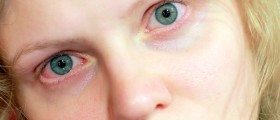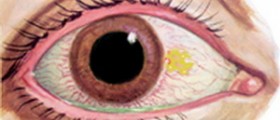
Apart from affecting humans, eye infections are also frequently reported in dogs. There are many reasons behind eye infections in dogs. The infection can be mild and easily brought under control, or moderate and even severe associated with complications.
In the majority of cases eye infections in dogs develop as a consequence of foreign matter or irritants. Dogs are also prone to conjunctivitis, dry eye and uveitis.
Most Common Eye Infections in Dogs
As far as foreign matter and irritants are concerned, these can easily enter the eye and cause infection even though dogs have a third eyelid. The presence of foreign matter and irritation caused by different chemicals and other irritants is associated with excess tearing, discharge and swelling of the eyelid. If foreign matter leads to a scratch of the cornea, the infection may be much more complex and even cause loss of vision.
Conjunctivitis (pink eye) is definitely the most reported eye infection in dogs. Inflammation of the inner membrane that covers the surface of the eyeball as well as inner surface of all eyelids is commonly a cause of redness of the eye and it is sometimes accompanied by mucous discharge coming from the eye.
Dry eye (keratoconjunctivitis sicca) is not an infection but the condition characterized by insufficient production of tears. However, dry eye is a major contributor to secondary infections and even more complex damage to the cornea such as corneal ulcers.
Finally, dogs may develop uveitis, an inflammation of the middle layer of the eye associated with blurry vision and pain in the affected eye.
Causes of Eye Infections in Dogs
Foreign matter and irritants may enter the eye inside the house or everywhere outside, in nature, in a park etc. Still, dogs who spend more time outdoors are at higher risk of contracting some foreign matter or be exposed to different irritants. Conjunctivitis is caused by bacteria or viruses as well as parasites. Dry eye is generally associated with other medical conditions such as distemper and hypothyroidism while uveitis may be bacterial, viral, fungal and sometimes even associated with rickettsia and protozoa.
Eye Infections in Dogs Treatment
Treatment depends on the underlying cause of eye infections and may include different medications which are most commonly administered in a from of eye drops or ointments.
Bacterial and viral infections are routinely treated with antibiotics and antiviral drugs. Dry eye requires artificial tears. Some eye infections additionally require specific anti-inflammatory drops, most commonly those containing Prednisone, dexamethasone or betamethasone. The treatment is successful and the dog soon fully recovers.

















Your thoughts on this
Loading...